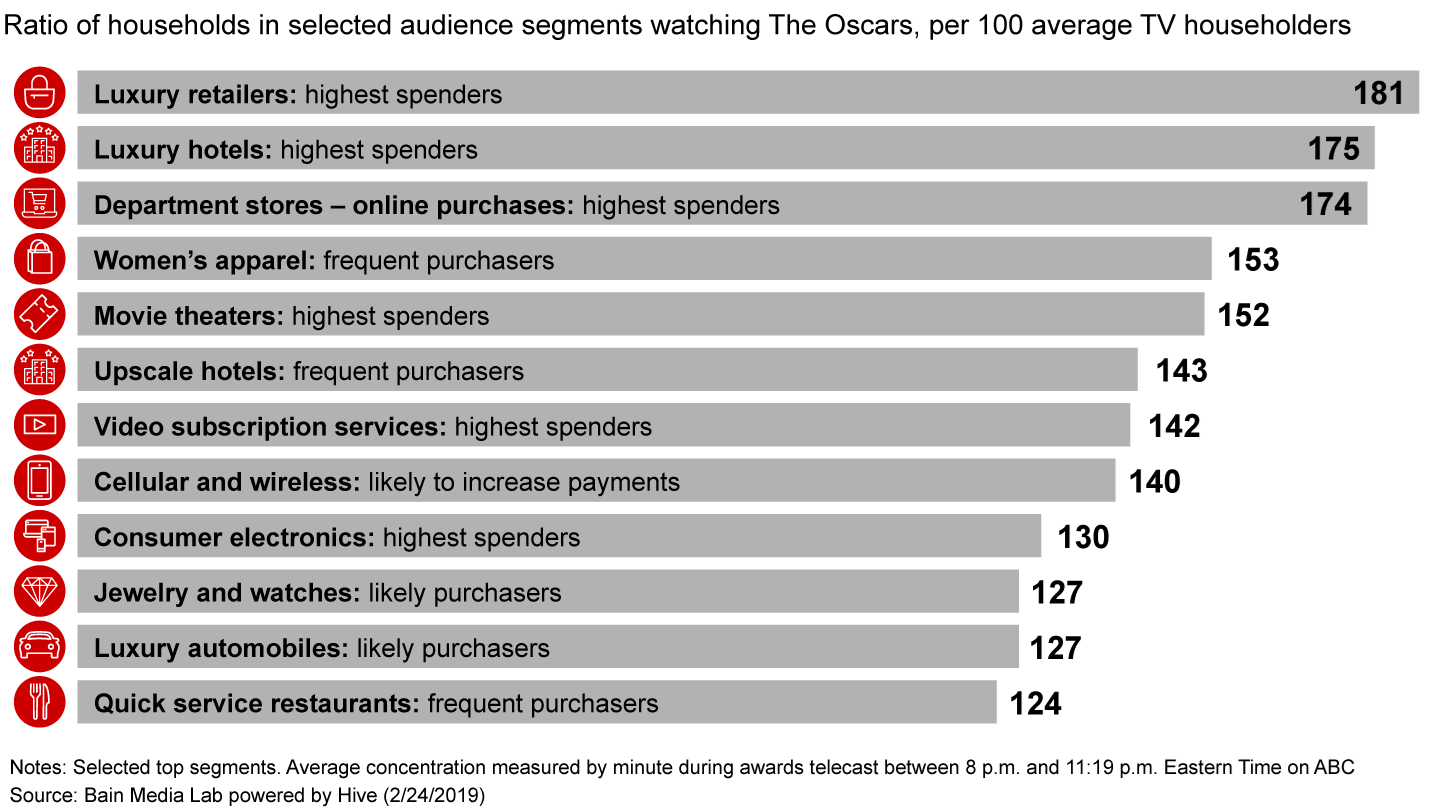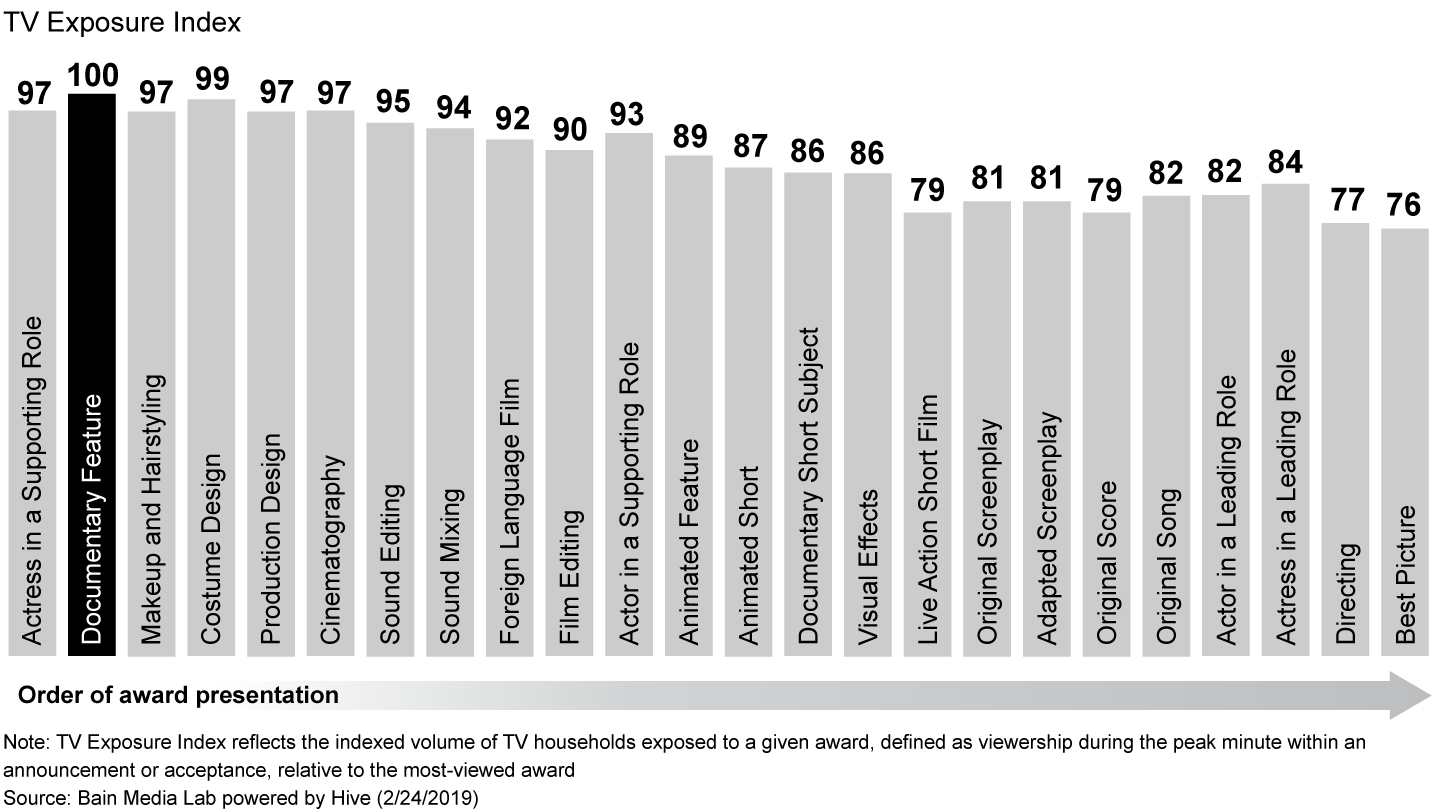Article

At a Glance
- As one of the premier live entertainment events on television, The Oscars remains a compelling forum for many top advertisers.
- Bain Media Lab and Hive analyzed this year's Academy Awards to assess audience profiles, celebrity exposure and viewership trends during the live telecast.
- Viewers of this year’s award show skewed towards affluent audiences in several premium categories, including frequent and top-spending consumers of luxury travel, retail and automobiles as well as, intuitively, top spenders at movie theaters and on video subscription services.
- The lack of an official host did not impact viewership trends, with 90% of the peak audience tuning in within the first 10 minutes. Lady Gaga received the most screen time during Sunday’s telecast, as measured by Hive computer vision technology.
Television’s tentpole live events, such as the Super Bowl and The Oscars, continue to reliably attract top advertisers. TV viewership may be facing headwinds, but brands still see these broadcasts as a compelling opportunity to reach large and engaged audiences.
At the same time, marketers have been conditioned by the speed and richness of data available to them in digital advertising. Increasingly, they are pushing TV networks and agencies to provide the same speed and granularity of data for their spending on TV ads, enabling a move from post-mortem analysis to real-time optimization. Networks are responding by investing in new capabilities to meet their advertisers’ needs, in the hopes that this will help them reclaim the narrative for TV advertising and pull back dollars from digital budgets. This dynamic is likely to shape the way TV ads and sponsorships are bought and sold in the very near future.

Bain Media Lab
Bain has teamed with AI pioneer Hive to develop and launch a co-branded product suite in the TV analytics space—bringing an unprecedented level of insight, measurement, and attribution to the TV advertising space.
To get a better idea of what “digital like” analysis of The Oscars audience would look like, Bain Media Lab, a collaboration between Bain & Company and Hive, evaluated who was watching this year’s broadcast, what they were seeing, and when they were tuned in.
Who was watching
The Oscars remain predictably one of the—if not the—most viewed nonsports telecasts each year. Components of The Oscars’ audience skew differently than those of major sporting events, like the NFL and College Football Playoff, which typically fill the ranks of other top telecasts. As a result, the Oscars offer a unique ability for marketers in certain categories to reach their target audience with a scale and concentration not otherwise available.
We profiled the viewing audience of The Oscars using a set of audience segments based on behavior, available in the Bain Media Lab platform, powered by Hive. Given the granularity of audience measurement from digital advertising platforms, it is important to achieve similar nuance in measuring television advertising. Even if age and gender demographics continue to remain central for the near-term buying and selling of TV advertising, richer audience intelligence can immediately improve the effectiveness of media plans and marketers’ return on investment. Advanced audiences within the Bain Media Lab platform include more than 250 behavioral segments defined by their spending—including highest spenders, frequent purchasers and likely purchases within a given category—as well as custom segments based on mobility data, such as store visitors and commuters.
The audience for this year’s Oscars skewed toward affluent, registering a 130 index—meaning that 30% more of the TV households with incomes greater than $100,000 were watching The Oscars than average TV households were. This means there were more viewers in several premium categories that are attractive to many brands, including some that invested in advertisements and sponsorships of The Oscars this year (see Figure 1).


As an example, Marriott International used The Oscars to introduce Bonvoy, the newly announced loyalty brand integrating the rewards programs of Marriott Rewards, The Ritz-Carlton Rewards and Starwood Preferred Guest (SPG). Of the 30 brands in the newly integrated Marriott portfolio, Marriott’s Bonvoy commercials specifically highlighted six luxury and upper upscale brands. These ads reached an audience indexing at 175 for top spenders at luxury hotels. This means that of the households that spend two or more times that of the average at luxury hotels—such as Ritz-Carlton, JW Marriott and W Hotels—75% more of those households were watching The Oscars than were average TV households. The audience also indexed at 143 for frequent transactors at upscale hotels, defined as those who stay at upscale and upper upscale hotels such as Westin and Sheraton two or more times as frequently than average.
On a night to celebrate last year’s film slate, trailers for Disney’s upcoming live-action remake of The Lion King and Netflix’s The Irishman were among the films that introduced themselves to audiences. Unsurprisingly, those trailers reached an audience skewed toward top spenders at movie theatres—a 152 index—and on online video subscription services—a 142 index.
Rapid, granular analysis of advanced audience measurement on linear TV allows for near real-time optimization of media plans, which can improve the efficiency and effectiveness of advertising spending on TV. Consider the premiere of a prime time drama. The ability to understand the audience before the second airing is valuable to buyers and sellers alike, helping sellers find the best fit for any available inventory and giving marketers better insight on how to fine-tune media plans.
What they were seeing
Earlier this week, we published a ranking of the celebrities who received the most screen time during Sunday's Oscars on ABC, using the same Hive computer vision models that measured brand exposure during last month's Super Bowl.

Which Celebrities Starred in the Oscars?
And the winners for most screen time during the Academy Awards are ...
While this ranking is more of a vanity metric than a true business insight, we believe tangible applications of computer vision for marketers and media companies will dramatically increase in the coming years. For example, computer vision provides a more scalable and accurate way to measure the media value of sponsorship placements and endorsement deals, compared with the legacy approach of people viewing footage and logging exposure in diaries. Further, as programmatic video buying continues to grow on digital channels and connected TVs, the ability to use computer vision to identify the context of content (for example, a scene in a restaurant) can create contextual advertising opportunities that could make ads more effective for marketers—and thus justify premiums for publishers.
One of the major story lines leading up to this year’s event was the lack of an official host for the first time in 30 years. With the host typically the center of early attention, this dynamic provided more screen time to go around.
Lady Gaga, who won the award for best original song, tallied the most screen time in the telecast, accumulating more than five minutes on screen with her acceptance speech, a performance of the Oscar-winning song “Shallow” with Bradley Cooper, and several camera shots in her front-row seat.
Alfonso Cuarón, who made three acceptance speeches for Netflix’s Roma—directing, cinematography, and foreign language film—received the second-highest screen time. Other award winners made up most of the top 10. Bradley Cooper (fifth highest) and Tina Fey (10th highest) were the only celebrities ranking in the top 10 of screen time who did not win awards. Cooper joined Lady Gaga on stage for the “Shallow” performance. Fey presented the evening’s first Oscar, for actress in a supporting role, alongside Amy Poehler and Maya Rudolph, who ranked 11th and 12th, respectively, with just a few less seconds in crowd shots than Fey (see Figure 2).


When they were tuned in
The lack of an official host did not appear to affect viewership trends, as the audience ramped up to 98% of the peak audience by the 10th minute of the program. Viewership levels stayed within 10% of the peak audience through the first hour of the program and within 20% of the peak during the second hour. The 3-hour and 19-minute broadcast concluded with 70% of the peak audience tuned in.
Free Solo won the award for best documentary feature, as well as the highest viewership level among awards during the telecast, according to viewership data within the Bain Media Lab platform, powered by Hive. This aggregates and scales live viewership data from a panel of more than 12 million US cable and satellite set-top boxes and smart TVs, providing second-by-second viewership of content and commercials (see Figure 3).


Awards season may now be over for the year, but the industry’s focus on television advertising is just ramping up with Upfronts looming—when many brands commit the majority of their annual television advertising budgets. Will this be the year that winners and losers are defined by those using better data?
Dan Calpin and Andre James are partners with Bain & Company in Los Angeles. Dan leads Bain Media Lab, and Andre leads Bain's Global Media & Entertainment practice. Elizabeth Spaulding is a Bain partner in San Francisco and coleads Bain’s Global Digital practice. Kevin Guo is cofounder and CEO of Hive, a full-stack deep learning company based in San Francisco that focuses on solving visual intelligence challenges.
Note: Published Bain Media Lab research relies solely on third-party data sources and is independent of any data or input from clients of Bain & Company.